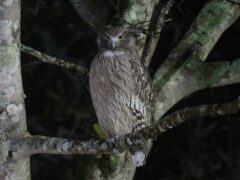Blakiston’s fish owl (Ketupa blakistoni) is the world’s largest owl and one of the most elusive. Endemic to remote riverine forests of northeast Asia, it is an apex predator uniquely adapted to hunt along streams and ice-free waters. Its massive frame, shaggy plumage, and specialized diet of fish and amphibians set it apart from other […]
Category: Strigiformes
25 of the world’s rarest owls, some are on the brink of extinction
The Siau scops owl and the Pernambuco pygmy owl are currently the rarest owls in the world, with likely fewer than 50 individuals remaining in the wild. Their populations are so critically low that they may soon vanish entirely unless immediate conservation action is taken. Close behind them are the Annobon scops owl, Seychelles scops […]
Rediscovery of the Flores Scops Owl Otus alfredi on Flores, Lesser Sunda Islands, Indonesia, and reaffirmation of its specific status
Flores Scops Owl (Otus alfredi) Science Article 1 abstract The Flores Scops Owl Otus alfredi remained unreported for almost a century after its description in 1897, and skepticism developed regarding its validity as a species. In 1994 a fourth individual (a juvenile) was collected near the type locality, and an adult was independently mistnetted and […]
Identification, distribution and status of the Forest Owlet Athene (Heteroglaux) blewitti
Forest Owlet (Heteroglaux blewitti) Science Article 1 abstract Re-evaluation of specimen and literature evidence established that only seven study skins of the Forest Owlet Athene (Heteroglaux) brama were ever collected, and only between 1872 and 1884. Examination of all seven specimens elucidated numerous diagnostic characters as well as the localities at which the species was […]
Rediscovery, biology, vocalisations and taxonomy of fish owls in Turkey
Brown Fish Owl (Ketupa zeylonensis) Science Article 1 abstract In the Western Palearctic (WP) region, Brown Fish Owl Bubo zeylonensis is one of the rarest and least-known birds. The species? range is huge, from the Mediterranean east to Indochina, but it is probably only in India and Sri Lanka that it is regularly observed. In […]
Diet of breeding Tengmalm’s Owls Aegolius funereus: long-term changes and year-to-year variation under cyclic food conditions
Boreal Owl (aegolius funereus) Science Article 5 abstract The diet of breeding Tengmalm’s Owl , A. funereus was studied in the Kauhava region, west Finland, using two methods: identification of prey animals cached in the nest-holes(a total of 4366 prey items in 1973-86) and found in the pellets and orher prey remains colletred from de […]
Tawny Owl’s territory occupancy in Eastern Latvia.
Tawny Owl (Strix aluco) Science Article 2 abstract The Tawny Owl’s territory occupancy was studied on twoplots in Eastern Latvia. By mapping Tawny Owl calling sites and by usingactivity stimulation, the spacing of pairs and solitary individuals was tracedover 6 years. The Tawny Owl population increased during the study. Ofdetected resident owls, 11% were single […]
Wood quality and the Tawny Owl Strix aluco in different foresttypes of central Italy
Tawny Owl (Strix aluco) Science Article 3 abstract We correlated breeding density and proportion of wooded area per territory of Tawny Owl Strix aluco measured in four deciduous forest types with forest elevation and songbird abundance, both regarded as estimators of forest productivity. The proportion of wooded area was positively correlated to forest elevation, being […]
Wood quality and the Tawny Owl Strix aluco in different foresttypes of central Italy
Tawny Owl (Strix aluco) Science Article 4 abstract The population of Tawny Owls Strix aluco breeding in urban Rome, Italy, was studied from 1992 to 2001. Yearly density (range: 0.9-1.1 territories km-2) was rather stable compared with data from central Europe, likely due to mild weather conditions and abundant food supply. The rate of territory […]
Possible first record of double brooding in the tawny owl Strix aluco
Tawny Owl (Strix aluco) Science Article 1 abstract […].A Tawny Owl population in Bizkaia was monitored between 1992 and 2003, producing a description of its breeding ecology (Zuberogoitia & Campos, 1998; Zuberogoitia & Martinez, 2000; Zuberogoitia, 2002). During the course of the study, one possible case of a second brood was registered. 1,700 Tawny Owl […]


